Dr. Art Slutsky steps down after 18-year career at the helm of Research at St. Michael’s
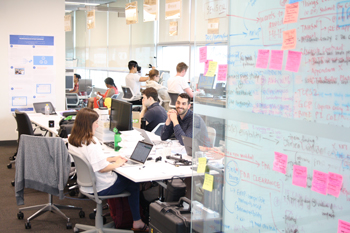
By Ana Gajic
A walk down memory lane: Dr. Art Slutsky’s colleagues reflect on his leadership over the past 18 years.
A love of solving problems and the potential to change the world first drew Dr. Art Slutsky to pursue research.
“As a doctor, you have an impact on the patients you care for – thousands of patients over a career,” Dr. Slutsky said.
“But as a researcher, your problem solving and ideas have the potential to impact millions of people. The intellectual stimulation of research, along with impact, made it very exciting for me.”
He had already completed two degrees in engineering before starting medical school at McMaster University. By the time he graduated, Dr. Slutsky was already a principal author on three academic journal articles. Since then, he has authored and co-authored hundreds of papers, contributing in particular to the study of injury in mechanical ventilation.
His commitment to research led him to become the first full-time vice-president of Research at St. Michael’s Hospital. Now, 18 years later, Dr. Slutsky has decided to step down from this role. He’ll continue his research in mechanical ventilation and find new ways to pursue his passion for problem solving.
Accepting the offer
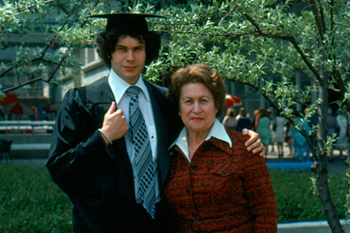
A love for solving problems, fostered by two degrees in engineering, drove Dr. Slutsky (pictured here with his mother, Rita) to pursue research.
With the new millennium on the horizon and a clear expectation that Toronto’s teaching hospitals should each have a robust research program, St. Michael’s named research as one of the key priorities in its strategic plan for the first time in 1999.
Meanwhile, Dr. Slutsky’s clinical and research career had taken him from McMaster to Boston, and back to Toronto. In 1999, he was a staff physician at Mount Sinai Hospital and a senior scientist at the hospital’s then-named Samuel Lunenfeld Research Institute (now known as the Lunenfeld-Tanenbaum Research Institute).
The search committee looking for the first-ever vice-president of Research at St. Michael’s asked Dr. Slutsky to come in for an interview. He initially turned down the opportunity because he was content with his role at Mount Sinai. A few months later, Jeff Lozon, then President and CEO of St. Michael’s, called Dr. Slutsky directly.
“We talked for about half an hour and I loved his vision,” Dr. Slutsky said, adding a conversation with his wife, Myra Slutsky, helped persuade him to take the position.
“She told me it was time for a new challenge and I agreed. If Jeff hadn’t called, this might never have happened. Looking back now, I’m very glad he did.”
Building Research at St. Michael’s
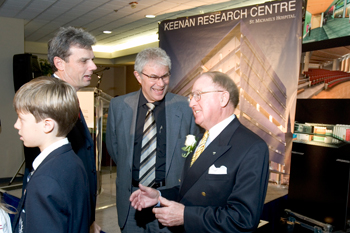
With the support of generous donors like Pat Keenan (far right) and his wife Barbara, and Mr. Li Ka Shing, the hospital was able to make a commitment to build the Li Ka Shing Knowledge Institute/Keenan Research Centre.
Over the next few years, Dr. Slutsky set out to bolster the ongoing research St. Michael’s and develop new streams. At the time, researchers were spread out across almost 10 sites due to a lack of space in the hospital.
“For good research, you want people bouncing ideas off each other and learning by osmosis, and if they’re all over the place, they can’t do that,” Dr. Slutsky said. He set out to solve this problem.
Under his leadership, in 2004, the hospital made a commitment to build a research building that would bring nearly all the St. Michael’s scientists under one roof. In 2011, the new research building, The Li Ka Shing Knowledge Institute/Keenan Research Centre opened its doors and St. Michael’s wet bench and dry bench scientists came together in the new tower, representing the collaboration Dr. Slutsky had started to build in Research.
When Dr. Slutsky started at St. Michael’s, researchers were receiving about $1 million in funding from the Canadian Institutes of Health Research (CIHR) and publishing about 400 journal articles a year. Now, the research enterprise receives almost $18 million from CIHR annually, and publishes more than 1,400 articles per year. More importantly, research from St. Michael’s has had an impact on public policy, and on how clinical care is provided world-wide in specific areas. It has developed a reputation as a creative and innovative research institution, whose research makes a real difference.
‘Recruit for brains, hire for personality’
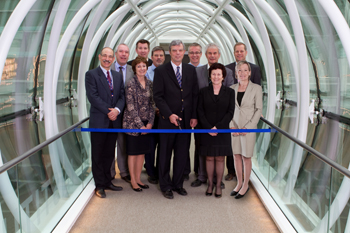
In 2011, the new research building opened its doors and brought St. Michael’s researchers together.
With new areas of research, Dr. Slutsky wanted to attract world-class researchers who would lead and build a culture of innovation. As a fellow in Boston, he had learned the importance of culture: it could be powerful enough to draw people in.
“You spend more awake hours with your colleagues than you do with your spouse and your family,” he said. “When you come to work, you want to enjoy coming to work. For myself and everyone here, I wanted to build a fun place to work.”
He did so by following a simple mantra: Recruit for brains, hire for personality.
“He hired people, who, much like himself, were interested in working together and collaborating,” said Dr. Bob Howard, former President and CEO of St. Michael’s. “It created a wave of people who are all trying to help each other.”
Regardless of whether they had in interest in dry bench or wet bench research at St. Michael’s, Dr. Slutsky wanted all scientists to be on the same team.
Timeline
|
“Art has built a culture of collective thinking outside of the box,” said Dr. Sharmistha Mishra, a scientist at Centre for Urban Health Solutions. “He has always encouraged us to share our learning with each other – it sincerely feels like we’re all in it together with lessons shared across scientists in formal and informal settings. He has role-modeled a true joy and excitement when it comes to science, and has shared our enthusiasm.”
This ability to share openly and willingly is a rare characteristic that Dr. Slutsky has embedded into the research enterprise, said Dr. Howard.
“Often researchers are competing with each other for limited grants, which can breed animosity,” he said. “But Art is the opposite. It doesn’t matter if you’re a researcher, or a clinician, or an administrator. Art is a collaborator.”
This attitude of openness has allowed him to be a leader on the clinical side of the hospital as well, Dr. Howard said. With his support, a culture of collaboration has extended beyond research and through the hospital walls.
“He was able to make a contribution to St. Michael’s that was much broader than the research agenda,” Dr. Howard said. “By so doing, he elevated the research agenda in the hospital.”
What’s next for Dr. Slutsky
Dr. Slutsky officially stepped down from his role as vice-president of Research on Sept. 1. His career in research and passion to find solutions to large-scale health problems will continue at St. Michael’s.
“I’m looking forward to having more time to think creatively,” Dr. Slutsky said. “And I hope I have at least one big discovery left.”
Dr. Patricia O’Campo, who holds the Chair in Intersectoral Solutions to Urban Health Problems and was most recently the interim executive director of the Li Ka Shing Knowledge Institute, has taken on the role of interim vice-president of Research. A full search will be undertaken this year to identify and appoint the next vice-president of Research.
To recognize Dr. Slutsky’s dedication and vision over the past 18 years, the St. Michael’s Hospital Foundation has helped establish the Arthur S. Slutsky Scholar In Residence (SIR) program. Supported by this program, an internationally renowned scientist will work in residence at the Li Ka Shing Knowledge Institute (LKSKI) for one year, providing research consultancy, mentorship and expertise to its scientists, staff members and trainees.
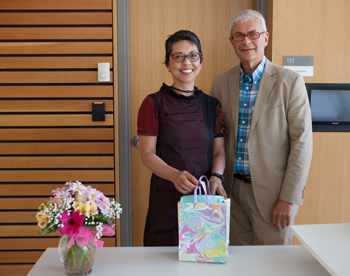
Dr. Patricia O’Campo, interim executive director of the Li Ka Shing Knowledge Institute, is the interim vice-president of Research at St. Michael’s.
The goals of the program will be to contribute to the intellectual environment of LKSKI, to advance the research productivity of the Institute and to make the LKSKI a desirable and unique home for scientists and students. In addition, to commemorate Dr. Slutsky’s leadership as the inaugural vice-president of Research at St. Michael’s, a portrait of him will be hung on the third floor of the LKSKI and Keenan Research Centre.
Dr. Slutsky will carry on mentoring early-career researchers and get more involved in research involving big data, along with some of the work going on in physiology and clinical trials in critical care. And he’ll keep tabs on the different centres of research that have made St. Michael’s a go-to information source for policymakers and governments.
“It makes me smile just to know that I had some small part in making all of this happen,” he said.
About St. Michael’s Hospital
St. Michael’s Hospital provides compassionate care to all who enter its doors. The hospital also provides outstanding medical education to future health care professionals in more than 29 academic disciplines. Critical care and trauma, heart disease, neurosurgery, diabetes, cancer care, care of the homeless and global health are among the Hospital’s recognized areas of expertise. Through the Keenan Research Centre and the Li Ka Shing International Healthcare Education Centre, which make up the Li Ka Shing Knowledge Institute, research and education at St. Michael’s Hospital are recognized and make an impact around the world. Founded in 1892, the hospital is fully affiliated with the University of Toronto.
St. Michael’s Hospital with Providence Healthcare and St. Joseph’s Health Centre now operate under one corporate entity as of August 1, 2017. United, the three organizations serve patients, residents and clients across the full spectrum of care, spanning primary care, secondary community care, tertiary and quaternary care services to post-acute through rehabilitation, palliative care and long-term care, while investing in world-class research and education.
